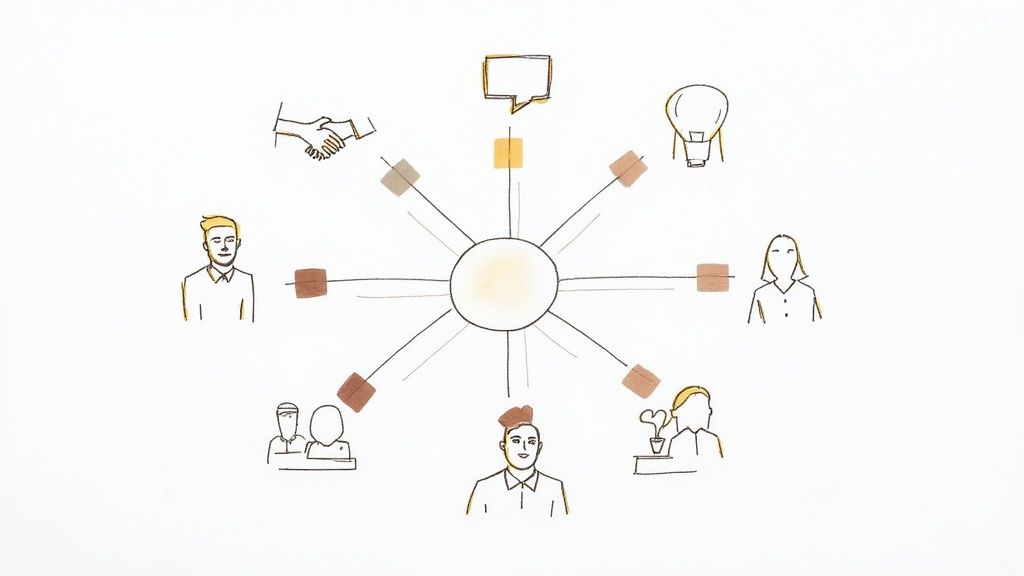October 11, 2025

In a world of fleeting digital connections, building a robust professional network has never been more critical or more misunderstood. Many view networking as a transactional, often awkward, exchange of business cards and rehearsed elevator pitches. But what if we reframed it as the art of building genuine, mutually beneficial relationships? The truth is, the most successful professionals aren't just collectors of contacts; they are architects of communities. They understand that a strong network is a safety net, a springboard for opportunities, and a source of invaluable knowledge.
This guide moves past the generic advice. We're diving into specific, actionable professional networking tips designed to transform your approach from superficial to strategic. For a fresh perspective on modern connectivity, you can also explore these additional AI-powered professional networking tips to stay ahead.
You will learn how to master active listening, provide value before asking for anything, perfect your follow-up, and maintain connections systematically. Whether you're navigating a conference, building an online brand, or nurturing existing relationships, these strategies will equip you to create connections that truly matter and accelerate your career growth. Let's get started.
In the fast-paced world of professional networking, it's easy to focus on what you're going to say next. However, one of the most powerful professional networking tips is to shift your focus from speaking to listening. Active listening is the practice of fully concentrating on, understanding, responding to, and then remembering what is being said. It’s about making the other person feel like they are the most important person in the room.
This technique moves beyond simply hearing words; it involves interpreting non-verbal cues and demonstrating genuine engagement. When you actively listen, you build trust and rapport, which are the foundations of any strong professional relationship. This approach transforms a transactional exchange into a meaningful connection, making you more memorable and respected.

Active listening is a cornerstone of effective communication, popularized by thought leaders like Stephen Covey and Dale Carnegie. Its impact is measurable. For instance, sales professionals who practice active listening report significantly higher success rates in building client relationships. Similarly, former LinkedIn CEO Jeff Weiner frequently credits active listening as a critical component of his leadership and networking philosophy, enabling deeper understanding and stronger alliances.
By truly hearing what your contacts are sharing about their challenges, goals, and interests, you can identify authentic opportunities to offer value. This is far more effective than a generic sales pitch and establishes you as a thoughtful, insightful resource.
Putting this principle into practice requires conscious effort and a few key strategies:
The most effective professional networking tips often run counter to our instincts. Instead of approaching networking with a "what can I get?" mindset, flip the script and ask, "what can I give?" This "give first" philosophy centers on offering help, sharing resources, or making introductions without any immediate expectation of receiving something in return. It’s about building a reputation as a generous, valuable connection.
This approach transforms your networking from a series of transactional encounters into the cultivation of genuine, long-term relationships. By leading with generosity, you build goodwill and trust, creating a strong foundation of reciprocity that pays dividends when you eventually do need assistance.

This principle is heavily promoted by influential thinkers and has proven results. Wharton professor Adam Grant's research in his book Give and Take demonstrates that "givers" consistently achieve greater long-term career success than "takers." Similarly, LinkedIn co-founder Reid Hoffman built the platform's initial network by connecting influential people and offering value long before the service became a global standard.
When you consistently provide value, you position yourself as a central node in your network, a resourceful problem-solver people want to know. This strategy, famously articulated by Gary Vaynerchuk as "Jab, Jab, Jab, Right Hook," involves delivering value repeatedly before ever making an ask, ensuring your request is well-received.
Adopting a "give first" mentality requires a proactive and strategic approach. Here are a few ways to put it into practice:
In professional networking, first impressions happen fast. An elevator pitch is a concise, compelling introduction that communicates who you are, what you do, and the value you provide in 30-60 seconds. Its name originates from the idea that you should be able to deliver it during a brief elevator ride. A well-crafted pitch is memorable, clear, and adaptable, opening the door for deeper conversations and new opportunities.
This powerful tool is not just a summary of your job title; it's a strategic narrative designed to pique curiosity and make a lasting impact. When you have a polished elevator pitch ready, you can confidently introduce yourself in any setting, from a formal conference to an unexpected encounter, ensuring you make every second count.

A strong elevator pitch is a critical asset in a professional's toolkit, a concept championed by communication experts like Carmine Gallo and Daniel Pink. The impact is significant: career coaches report that professionals with refined pitches receive up to three times more follow-up conversations. Furthermore, startup founders with clear elevator pitches are 40% more likely to secure investor meetings.
Instead of a generic "I'm a marketing manager," a well-honed pitch focuses on the outcome you deliver. This shifts the conversation from your title to your value, making you a memorable problem-solver rather than just another contact. It’s a fundamental tool among the most effective professional networking tips because it frames your expertise in a way that resonates with others' needs.
Crafting and delivering a great pitch requires structure and practice. Here are a few key strategies to perfect yours:
The real work of networking often begins after the initial conversation ends. A brief exchange at an event is just the starting point; the follow-up is where a fleeting contact transforms into a lasting connection. Strategic follow-up means reaching out to new contacts within 24 to 48 hours, while your conversation is still fresh in their memory. This simple, timely action signals professionalism, reinforces your value, and shows genuine interest in building a relationship.
Failing to follow up quickly is one of the most common networking mistakes, leaving potential opportunities to fade away. By acting decisively, you distinguish yourself from the crowd and lay the groundwork for a meaningful professional alliance. This practice is not just about being polite; it's a critical step in nurturing the seeds of your network.

Timeliness in communication is a powerful tool. Networking experts like Harvey Mackay, author of "Dig Your Well Before You're Thirsty," have long emphasized that the fortune is in the follow-up. The data backs this up: a study highlighted in the Harvard Business Review found that immediate follow-up can increase response rates by a staggering 391%. The window of relevance closes quickly, and your impact diminishes with each day that passes.
This professional networking tip is about maintaining momentum. When you send a personalized message shortly after meeting someone, you solidify your place in their mind. You’re no longer just another face in the crowd but a proactive, organized, and memorable professional who values connection.
Executing a memorable follow-up is an art that combines speed with substance. Here are a few actionable ways to master this skill:
In today's digital-first world, your professional network isn't just built in conference halls; it's cultivated online. Building an online presence through thought leadership means consistently sharing your unique expertise, insights, and perspectives on platforms like LinkedIn, industry blogs, or other professional social media. This strategy shifts your approach from actively seeking connections to attracting them organically.
This method establishes a powerful digital footprint that showcases your credibility and value. Instead of just being another face in the crowd, you become a go-to resource in your field. This attracts inbound opportunities, from job offers to speaking engagements, and allows your network to grow beyond any geographical or physical limitations.

Thought leadership has been popularized by figures like Simon Sinek, whose "Start With Why" concept became a global phenomenon through online content, and Brené Brown, who built a massive following by sharing her research on vulnerability. The impact is clear: LinkedIn's own data shows that professionals who regularly post valuable content receive significantly more profile views and inbound messages.
By consistently offering value without an immediate ask, you build a reputation as a generous and knowledgeable expert. This is a crucial one of many professional networking tips for the modern era because it scales your influence and establishes trust before you ever meet someone in person. People begin to seek you out, flipping the traditional networking dynamic on its head.
Becoming a thought leader doesn't happen overnight, but it's achievable with a consistent, strategic approach:
The traditional image of networking often involves frantically "working the room" to collect as many business cards as possible. A more effective professional networking tip is to completely reverse this approach. Adopting a quality-over-quantity mindset means prioritizing a handful of deep, meaningful conversations over dozens of superficial exchanges. It's about building genuine rapport, not just expanding your contact list.
This strategy transforms networking from a numbers game into an opportunity for authentic connection. By focusing on having just three to five substantial conversations, you can invest the time to truly understand someone's goals, challenges, and interests. This depth is what creates memorable interactions and lays the groundwork for lasting professional relationships.
Networking experts like Keith Ferrazzi and BNI founder Ivan Misner have long championed this focused approach. Its power lies in its efficiency and impact. Mark Cuban, for instance, advises entrepreneurs to spend quality time with fewer people rather than trying to meet everyone. The goal isn't a stack of cards; it's a few solid leads for future collaboration and mutual support.
This method allows you to identify genuine opportunities for mutual value. A deep conversation can reveal shared projects, complementary skills, or potential client referrals that a fleeting, 30-second introduction would never uncover. This focus on depth is what separates amateur networkers from strategic relationship-builders.
Adopting this mindset requires a clear plan and intentional action, both before and during an event:
In an era of digital noise, cold outreach often feels like shouting into the void. A far more effective strategy is to leverage warm introductions, which involve being introduced to a new contact by a mutual connection. This approach fundamentally changes the dynamic of the first interaction, replacing the skepticism of a cold call with the implicit trust and credibility transferred from your shared contact.
A warm introduction acts as a powerful endorsement. Instead of having to build rapport from scratch, you begin the conversation with a foundation of trust already in place. This method dramatically increases the likelihood of getting a positive response, turning a potential dead end into an open door and making it one of the most essential professional networking tips for anyone looking to make meaningful connections.
The power of warm introductions is backed by compelling data and championed by networking experts. LinkedIn co-founder Reid Hoffman built this concept into the platform’s core functionality, recognizing that a shared connection significantly boosts engagement. According to LinkedIn's own data, you are 5x more likely to get a response if you reach out through a shared connection.
This principle is the gold standard in high-stakes environments like venture capital, where VCs give significantly more consideration to pitches that come through a trusted source. Networking guru Adam Rifkin, once named Fortune's "best networker," built his reputation on the power of making thoughtful, high-value introductions. It proves that who you know is important, but who knows you and is willing to vouch for you is even more critical.
Effectively securing and utilizing warm introductions requires a thoughtful and respectful approach:
The energy of a networking event often fades, leaving behind a stack of business cards and good intentions. One of the most critical professional networking tips is to move beyond simply collecting contacts and start actively cultivating them. Adopting a Customer Relationship Management (CRM) approach means treating your network with the same systematic care that businesses use to manage their client relationships. It's about intentional, scheduled nurturing to ensure connections deepen over time rather than fizzling out.
This methodical practice transforms networking from a series of random encounters into a strategic asset-building activity. By tracking interactions, key details, and follow-up schedules, you prevent valuable relationships from falling dormant. This ensures you're always top-of-mind not because you're the loudest voice, but because you're the most consistent and thoughtful connection.
Pioneered by networking legends like Harvey Mackay with his "Mackay 66" system, this disciplined approach is proven to build powerful alliances. Author and entrepreneur Keith Ferrazzi also champions this idea, emphasizing that successful networking is about generosity and diligence, not just charisma. Top executive recruiters, for example, rely on sophisticated CRM systems to manage thousands of relationships, ensuring they can connect the right person with the right opportunity at the perfect moment.
When you systematically manage your network, you create a powerful database of allies and resources. It allows you to add personalized, timely value, whether by remembering a key project detail, a personal milestone, or a professional need. This level of intentionality sets you apart and builds a reputation for being reliable and genuinely invested in others' success. To efficiently manage your growing list of connections, exploring the top contact management software can be incredibly beneficial.
You don't need expensive software to start; a simple spreadsheet can be just as effective. The key is consistency.
The journey from a novice networker to a master connector isn't paved with a mountain of business cards. Instead, it’s built on a foundation of genuine human connection, consistent effort, and strategic action. The eight professional networking tips detailed throughout this article are more than just a checklist; they are interlocking components of a powerful, modern approach to building a resilient and supportive professional ecosystem.
By internalizing these strategies, you shift your perspective from simply collecting contacts to actively cultivating a community. You move from transactional exchanges to transformational relationships. The core principle that binds these tips together is a commitment to authenticity and value. It’s about listening more than you speak, giving before you ask, and focusing on the quality of your interactions rather than the sheer quantity. This mindset is what separates fleeting connections from lasting professional allies.
Let's distill the core takeaways from the strategies we've explored:
The true value of this knowledge lies in its application. Reading about networking is easy; doing it consistently is what builds careers. Don't try to implement everything at once. Instead, choose one or two areas to focus on this month.
Mastering these professional networking tips is an investment in your future. It's about building a support system that can provide advice, open doors, and offer collaboration opportunities throughout your career. The strongest professional networks are not just lists of names; they are vibrant communities of mutual support, respect, and shared value. Start treating your network as such, and you will unlock a new level of professional growth and fulfillment.
Ready to apply these principles at scale for your organization or community? GroupOS provides the all-in-one platform you need to manage events, engage members, and facilitate meaningful connections effortlessly. See how GroupOS can help you turn your contact list into a thriving, engaged community.


